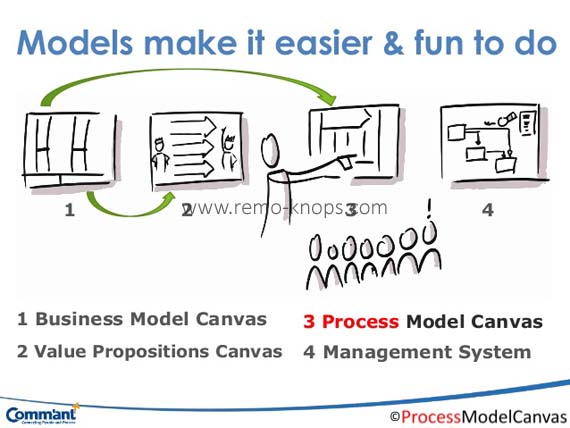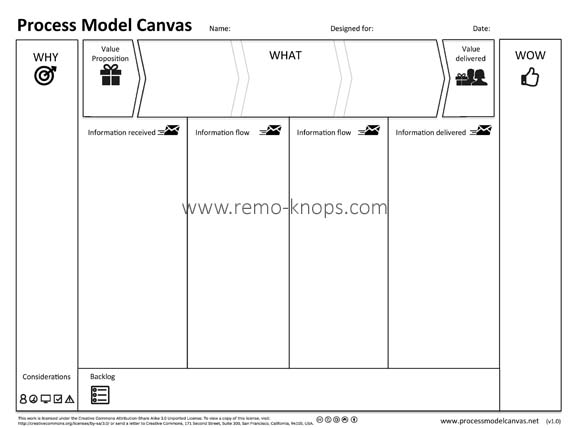The Process Model Canvas is developed by Marco Bijl, James P. Devlin and David Ruting and is complementary to Alexander Osterwalder’s Business Model Canvas. The PM Canvas will help you define the operating model that needs to be adopted, but HOW do you do that?
TABLE OF CONTENTS
Business Model Canvas vs Process Model Canvas
The Business Model Generation handbook was launched back in 2009, with the Osterwaler’s Business Model Canvas as the central tool to innovate business models. After the book launch I wrote two articles describing the Business Model Canvas and answering the question “What is a Business Model?“
In 2014 the same team published the book Value Proposition Design, with the Value Proposition Canvas as the central model of that book. The book focuses on the fit between the customer segments and the value propositions in the Business Model Canvas. The Value Proposition Canvas is again a visual tool that helps you finding this fit.
If you defined a Value Proposition that fits best you need to work on the left side of the business model canvas by defining key activities, based on key partners and key resources. That sounds a like defining a process and operating model. 🙂
The Process Model Canvas is a plugin for the Business Model Canvas. It is a visual tool that helps you connect the strategically used business model canvas to a practical operational model. The PM canvas helps to visualize the process (key activities, key resources and key partners) and the various dependencies in the process, such as collaboration and information flow and roles involved for each process step.
The section below will focus on further explaining the canvas and how it can be used.
Process Model Canvas Explained
Marco Bijl published a the video below that explains the Process Model Canvas in 5 minutes based on a practical example of two friends that start a Design Man’s Fashion Shop.
In addition you might want to check out the PMC SlideShare presentation of David Ruting, which gives some more context.
How to use the Process Model Canvas
On the PMC website there is an excellent how to section, which provides a step by step guide on how to use the Process Model Canvas. The first phase will help to …
Design your key activities (KA)
- Print the Process Model Canvas on at least an A3 paper;
- In the Business Model Canvas you defined your Key Activities (KA). Take one of them and place this Key Activity in the PM Canvas as the Process chain name;
- Start to discuss with the team about ‘The Wow’ effect for the customer. With what information, will the customer have this feeling. What make the difference? Use ‘sticky-notes’ and place them on the PM Canvas paper;
- Define the (sub) process names;
- Specify the information flow. From ‘message delivered’ to ‘message received’ (from the end to the beginning);
- Identify Risks;
And the second phase is …
Evolve the process model
- Define the Business Process Owner of the Key Activities;
- Enrich model with Considerations
- The PM Canvas, is the starting point to design the process, in line with the needs;
The approach described by Marco, James and David Ruting very much feels like when you are working with the business model canvas, however now with a focus on a specific key activity. Furthermore I really like the term “wow-effect for the customer” and reverse engineer the different process steps needed.
The visual one-pager helps you iterate quickly and collaborate with others easily in this process model innovation. 🙂 Download the PM Canvas one-pager in PDF-format below or head over to the Process Model Canvas website and download it from there.
Concluding thoughts and wrap-up
The Process Model Canvas, developed by Marco Bijl, James P. Devlin and David Ruting, is an interesting and valuable addition on top of Osterwalder’s Business Model Canvas.
The wow-effect for the customer, the why and the what sounded familiar like Simon Sinek’s Start with the why-terminology. 🙂
However the Process Model Canvas provides a structured approach and have a thorough discussion based on a single visual overview. Although the PM Canvas is not part of the International Institute of Business Analysis (IIBA) Business Analysis Body of Knowledge, it is a very practical and actionable tool to use.
Personally I’m looking forward to the PM Canvas book that’s under development. Are you using the Process Model Canvas?



Here is another useful hyperlink, with an e-book on process-management (in Dutch).
https://procesje.nl/spulletjes.html
The website is from Emiel Kelly